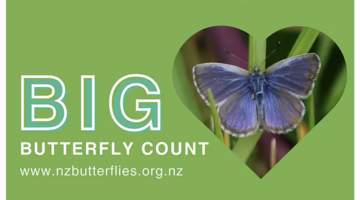

Butterflies make very poor fossils. They have no bones or other solid matter that can be preserved. Therefore, unlike other animals, we can’t use their fossils to trace the history of when they ...
READ MORE

What do kiwi, tuatara and many butterflies have in common in New Zealand? They are all native animals that the average person rarely sees in the wild. If you ask most people about butterflies ...
READ MORE

Adventure is engaging in an unusual or daring experience. Discovery is the act of finding or learning something for the first time. Adventure and discovery are both pretty exciting prospects – so ...
READ MORE

In this activity, students set up and walk a transect to observe and record butterfly sightings. They act as citizen scientists to monitor changes in the local environment. Modify this activity ...
READ MORE

In this activity, students place small stickers (tags) onto caught or newly emerged monarch butterflies and release them into the environment. The tag number, information about the butterfly and ...
READ MORE

In this activity, students use white butterfly eggs, larvae and pupae to examine the white butterfly life cycle and to compare it with that of a monarch butterfly. By the end of this activity ...
READ MORE

iNaturalist logs hundreds of thousands of photos of flora, fauna and fungi. There are even sound recordings too. Each is described and geo located. iNaturalist is used by citizens and scientists ...
READ MORE

This New Zealand-based citizen science project collects data about butterflies in our gardens, schools, parks and farms – any location in the country or on the outer islands. This annual event – ...
READ MORE

This project involves the pesky Pieris rapae (better known as the white butterfly or white cabbage butterfly), which is very common in Aotearoa New Zealand. It is believed to have originated in ...
READ MORE

This unit plan is designed for students in years 1–5. When someone mentions the word ‘butterfly’, what image pops into your head? Chances are it’s the monarch or the white butterfly, as these are ...
READ MORE

In this online PD session recorded on 30 July 2015, primary school teacher Angela Schipper describes how she used the Butterflies resources from the Science Learning Hub in the classroom. In ...
READ MORE

Investigate insects found in New Zealand to answer questions about life cycles, classification, conservation and biosecurity. Start by watching our webinar All about insects. Below are links to a ...
READ MORE
Dr Robert Hoare, of Landcare Research NZ Ltd, takes us on a moth-collecting expedition. Join Dr Hoare as he goes out at night to collect moths for scientific study.
READ MORE
Dr Robert Hoare, of Landcare Research NZ Ltd, introduces us to the world of moths. He describes their place in the ecosystem and how important they are to maintaining bird populations and their ...
READ MORE
Dr Robert Hoare, of Landcare Research NZ Ltd, shows us the process he uses to rear moths in the laboratory, using basic equipment such as a plastic lunchbox to grow eggs and caterpillars into ...
READ MORE

Most of New Zealand's butterflies belong to the Nymphalidae and Lycaenidae families. Use the Slideshow menu for further options, including view full screen, and go here for the download option.
READ MORE

Use this Aotearoa New Zealand native butterflies slideshow to learn more about native butterfly habits and behaviour, then go butterfly hunting! Use the Slideshow menu for further options ...
READ MORE

The life cycle of the monarch butterfly. Click on one of titles to find out more about each stage. Select here to view the full transcript and copyright information.
READ MORE